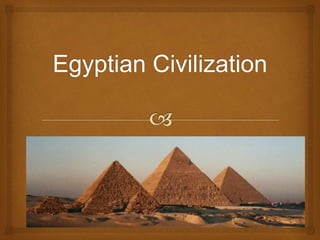
Pp.honors.egyptian civ.ch.1
- 2. Egyptian Geography • 2 Important geographical divisions: Upper Egypt (south) – Nile valley Lower Egypt (north) – Nile Delta • Unification 3100 B.C.E. – King Menes of Lower Egypt • Egyptians also made a distinction between • “Black land” – dark fertile fields along the Nile • “Red land” – desert cliffs andd plateaus bordering the valley
- 3.
- 4. Importance of Nile • Rains of central Africa => Nile to rise over its floodplain => left a rich layer of fertile silt • Construction of canals, dams & irrigation ditches to control river’s water and careful planning + organization of planting and harvesting • Led to agricultural prosperity unmatched in ancient world • Served as major highway connecting Upper and Lower Egypt
- 5. Egyptian History 3,000-year span of ancient Egyptian history History divided into 31 royal dynasties Old Kingdom (2700 -2200 B.C.E.) Rulers became called pharaohs (considered god) Pyramids – pharaonic tombs Middle Kingdom (2025-1630 B.C.E.) King became more directly concerned with his people Power of the pharaohs becomes more limited New Kingdom (1550-1075 B.C.E.) Military expansion and empire
- 6. What’s so remarkable about pyramids? Great technical skill they demonstrate Concentration of resources they represent Proof of pharaoh’s vast wealth Proof of the great organization and power of pharaohs to organize enormous human effort over the years it took to build each pyramid.
- 7. Pyramids at Giza: The three largest pyramids of Egypt, located at Giza, near Cairo, are the colossal tombs of pharaohs of the Fourth Dynasty (ca. 2640–2510 B.C.E.): Khufu (right), Chafre (center), and Menkaure (left). The small pyramids and tombs at their bases were those of the pharaohs’ queens and officials.
- 8. Important Gods & Goddesses • Amon-Re – the great lord of the Egyptian gods • Osiris – Egyptian god of the dead and judge of souls seeking admission to the afterlife • Isis – wife of Osiris; taught women to grind corn, spin flax, weave cloth, and care for children
- 9. Egyptians worshipped many gods and goddesses, who showed very human traits. Osiris was killed by his brother, who scattered the body across Egypt. Isis found the pieces and put them together. Pharaohs claimed their right to rule from the chief god, Amon-Re. Around 1380 B.C. the pharaoh Akhenaton ordered priests to honor only Aton, a minor god, but he was unsuccessful. Ordinary people related to the story of Osiris and his wife Isis.
- 10. Osiris became god of the dead and judge of souls seeking admission to the afterlife. • Osiris and Isis promised eternal life, even to lowly peasants, if they proved worthy. • Dead souls were ferried across a lake of fire to the Hall of Osiris for judgment. • Sinners were fed to the crocodile-shaped Eater of the Dead. • Souls who passed the test entered the Happy Field of Food to live in bliss for eternity.
- 11. Afterlife Egyptians believed that the afterlife was much like life on Earth • Buried the dead with everything needed for the afterlife. • Mummification preserved the body for use in the afterlife – preservation of body seen as essential for continued existence in the afterlife •Embalmers removed the internal organs, filling the body cavity with linen and drying powder. The body was wrapped in strips of linen and placed in the coffin.
- 12. Book of the Dead • Served as a guide in the afterlife • To avoid dangers of afterlife, used spells from the book Osiris sits in judgment as souls are weighed on a scale.
- 13. Pharaohs of the New Kingdom were buried in the Valley of the Kings. Over time, robbers looted most of the Archaeologists learned a great deal from the huge wealth of items buried with “King Tut.” pharaohs’ tombs. In 1922, archaeologist Howard Carter unearthed the untouched tomb of the young pharaoh Tutankhamen.
- 14. EGYPTIAN HIERARCHY Pharaoh Royal family High priests and priestesses, government officials, merchants, scribes, artisans Egyptian society was Peasant farmers and slaves highly stratified
- 15. Most Egyptians were farmers. Men worked the fields. In the off-season, they worked on the pharaoh’s construction projects. Women also worked in the fields, raised the children, collected water, cleaned, and cooked. Egyptian society also included many slaves.
- 16. Educated scribes played a central role in Egyptian Scribes: Often acquired additional skills in mathematics, medicine, or engineering Served government officials and the pharaoh Scribes chiseled official histories into stone, but everyday writing was done with reed pens and ink on strips of paperlike papyrus. Recorded ceremonies, taxes, and gifts society
- 17. Scribes developed a system of writing using symbols and pictures called hieroglyphics “sacred carvings” A cursive form called hieratic script, and later demotic script, used simplified symbols.
- 18. WOMEN IN EGYPTIAN SOCIETY • Egyptian women enjoyed greater rights than in other ancient civilizations. • Women could inherit property, go into business, obtain a divorce, and go to court. • Women entered the priesthood, serving goddesses. • However, women could not become scribes or hold government jobs. Hatshepsut wore a beard – ruled Egypt for 20 years
- 19. Egyptian Doctors Egyptians were knowledgeable about the human body. • learned about the body from mummification. • performed complex operations. • diagnosed many diseases. • prescribed medicines from plants such as anise, castor beans, and saffron, which are still used today.